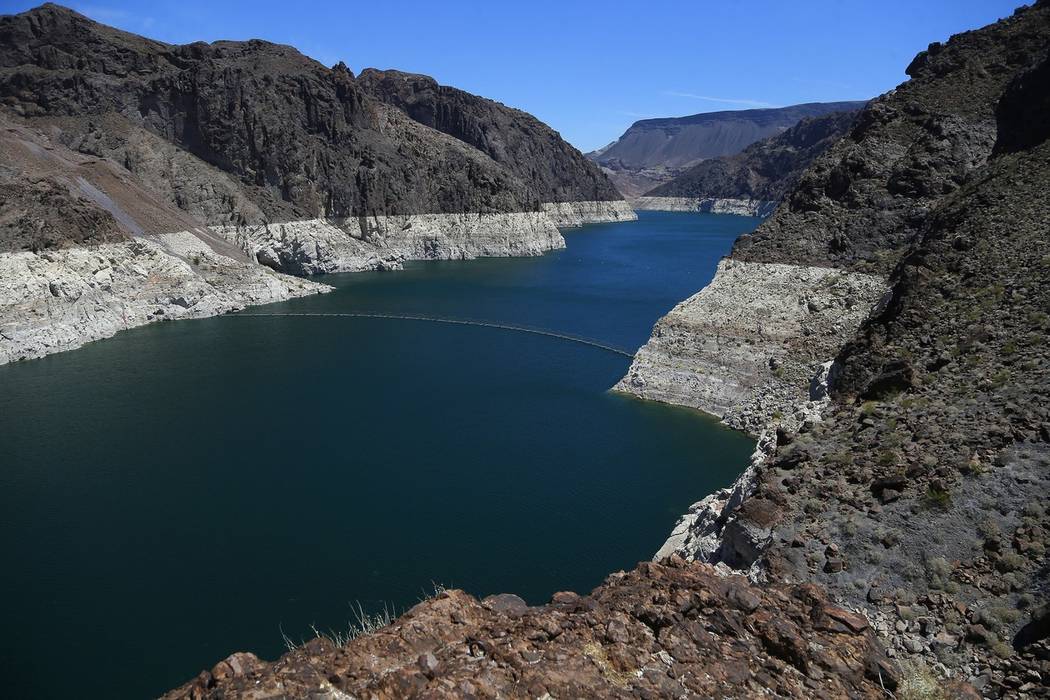Arizona approves Colorado River drought plan before deadline

What a difference a deadline makes.
Arizona lawmakers ceased their squabbling and signed on to a Colorado River emergency drought plan Thursday afternoon, just hours before they ran out of time to avoid federal intervention.
Arizona Gov. Doug Ducey signed the finished legislation within minutes of the final vote.
“I applaud our partners in Arizona for getting this across the finish line,” said Southern Nevada Water Authority General Manager John Entsminger. “I think it’s a monumental step toward protecting the Colorado River.”
The Grand Canyon State was the last major holdout on the Lower Basin Drought Contingency Plan, which calls for Nevada, Arizona and, eventually, California to voluntarily reduce their use of the river to leave more water in Lake Mead.
Arizona would give up 192,000 acre-feet of water, and Nevada would give up 8,000 acre-feet under the first round of annual cuts, set to kick in Jan. 1. California would join in the reductions, surrendering 200,000 acre-feet a year, should Lake Mead’s water level shrink another 41 feet from where it is now.
One acre-foot of water will supply two average Las Vegas Valley homes for just over one year. The valley gets about 90 percent of its water from the Colorado by way of Lake Mead.
During an appearance in Las Vegas in December, U.S. Bureau of Reclamation Commissioner Brenda Burman gave the states until Jan. 31 to finalize their emergency drought response. If they didn’t, she said, the federal government would start work on its own plan to keep Lake Mead from crashing.
Burman scheduled a Friday morning news conference to discuss whether Thursday’s deadline was met to her satisfaction.
Not done yet
More action will be needed either way.
Congress still needs to pass legislation ratifying portions of the interstate deal, and California’s little-known but powerful Imperial Irrigation District has yet to give its final blessing.
The agricultural district is the largest water user on the Colorado, with senior rights to more than 10 times as much river water as Nevada gets each year. Board members for the district gave conditional approval to the drought contingency plan in December, so long as the final package includes federal funding to stabilize the Salton Sea and stave off a looming environmental disaster in the California desert.
Lake Mead has seen its water level drop about 130 feet since drought took hold in the mountains that feed the Colorado River in 2000.
Current projections call for the massive reservoir east of Las Vegas to shrink by another 18 feet by the end of the year — low enough to trigger a first-ever federal shortage declaration and mandatory cuts by Nevada and Arizona on top of the voluntary ones included in the new drought deal.
Nevada would give up 21,000 acre-feet of water next year under those combined cutbacks, while Arizona would have to live without 512,000 acre-feet.
Those reductions aren’t expected to directly affect water users in the Las Vegas Valley. According to the Southern Nevada Water Authority, valley residents have already conserved more than enough water to absorb any voluntary or mandatory cuts expected in the near future.
Colorado River water managers started working on the drought plan in 2015. Nevada became the first of the seven river states to ratify the agreement in November through separate votes by board members from the Southern Nevada Water Authority and the Colorado River Commission of Nevada.
More talks ahead
Assuming it’s ratified by everyone involved, the finished plan would free Nevada to store more water in Lake Mead and allow withdrawals from its “savings account” even when the Colorado River is in shortage.
The plan would also trigger provisions in an earlier treaty agreement allowing Mexico to increase its Lake Mead storage while shouldering an equal share of cuts in river water usage.
The series of escalating cuts by Nevada, Arizona, California and Mexico could eventually total more than 1.37 million acre-feet a year, but they won’t immediately halt Lake Mead’s decline. Only Mother Nature can do that, said Colby Pellegrino, director of water resources for the Southern Nevada Water Authority.
The drought contingency plan “is designed to keep the system from failing” by stabilizing Lake Mead, Pellegrino said. “That stabilization might occur lower down than Lake Mead is today.”
More long and painful negotiations lie ahead for water managers. Starting in 2020, the seven states will renegotiate the operating guidelines for the Colorado and its two largest reservoirs. Those rules were adopted in 2007 and are set to expire in 2026.
If nothing else, Pellegrino said, the talks that led to the drought contingency plan have set the stage for the next round of water wrangling.
“It was a real heart-to-heart discussion about how we operate this basin with less water,” she said.
Contact Henry Brean at hbrean@reviewjournal.com or 702-383-0350. Follow @RefriedBrean on Twitter.
(Mostly) done deal
Arizona officials signed off Thursday on a new Colorado River Drought Contingency Plan. The interstate agreement calls for the following voluntary cuts based on the water level in Lake Mead, which sits at about 1,086 feet above sea level:
Jan. 1 lake level between 1,090 and 1,045 feet:
— Nevada: 8,000 acre-feet.
— Arizona: 192,000.
At or below 1,045 and above 1,040 feet:
— Nevada: 10,000.
— Arizona: 240,000.
— California: 200,000.
At or below 1,040 feet:
— Nevada: 10,000.
— Arizona: 240,000.
— California: starts at 250,000 and increases by 50,000 for each additional 5-foot drop in the lake.
One acre-foot of water will supply two average Las Vegas Valley homes for just over one year.













